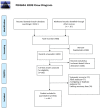Gastrointestinal symptoms and fecal nucleic acid testing of children with 2019 coronavirus disease: a systematic review and meta-analysis
- PMID: 33082472
- PMCID: PMC7576139
- DOI: 10.1038/s41598-020-74913-0
Gastrointestinal symptoms and fecal nucleic acid testing of children with 2019 coronavirus disease: a systematic review and meta-analysis
Abstract
In order to understand the clinical manifestations and incidence of gastrointestinal symptoms of coronavirus disease (COVID-19) in children and discuss the importance of fecal nucleic acid testing.We retrospectively analyzed studies on gastrointestinal symptoms and fecal nucleic acid detection in pediatric COVID-19 patients from January 1, 2020 to August 10, 2020, including prospective clinical studies and case reports. The results of fecal nucleic acid detection were analyzed systematically. Stata12.0 software was used for meta-analysis.The results showed that the most common gastrointestinal symptoms in children with COVID-19 were vomiting and diarrhea, with a total incidence of 17.7% (95% Cl 13.9-21.5%). However, the prevalence of gastrointestinal symptoms in other countries (21.1%, 95% CI 16.5-25.7%) was higher compared to China (12.9%, 95% CI 8-17.7%). In Wuhan, the pooled prevalence was much higher (41.3%, 95% CI 3.2-79.4%) compared to areas outside Wuhan in China (7.1%, 95% CI 4.0-10.3%). The positive rate of fecal nucleic acid testing in COVID-19 children was relatively high at 85.8% (91/106). Additionally, 71.2% (52/73) were still positive for fecal nucleic acid after respiratory tract specimens turned negative. One and two weeks after the respiratory tract specimens turned nucleic acid-negative, 45.2% (33/73) and 34.2% (25/73) patients, respectively, remained fecal nucleic acid-positive. The longest interval between the respiratory tract specimens turning negative and fecal specimens turning negative exceeded 70 days. Conclusions and relevance: gastrointestinal symptoms in pediatric COVID-19 are relatively common. Attention should be paid to the detection of fecal nucleic acids in children. Fecal nucleic acid-negative status should be considered as one of the desegregation standards.
Conflict of interest statement
The authors declare no competing interests.
Figures
References
-
- Feng C, Zhisheng L, Furong Z, et al. China's first critically ill child novel coronavirus. Chin. J. Pediatr. 2020;58:1.
Publication types
MeSH terms
Substances
LinkOut - more resources
Full Text Sources
Medical




